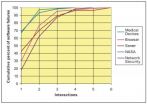(Press-News.org) UPTON, NY - Stop-and-go driving can wear on your nerves, but it really does a number on the precious platinum that drives reactions in automotive fuel cells. Before large fleets of fuel-cell-powered vehicles can hit the road, scientists will have to find a way to protect the platinum, the most expensive component of fuel-cell technology, and to reduce the amount needed to make catalytically active electrodes.
Now, scientists at the U.S. Department of Energy's (DOE) Brookhaven National Laboratory have developed a new electrocatalyst that uses a single layer of platinum and minimizes its wear and tear while maintaining high levels of reactivity during tests that mimic stop-and-go driving. The research - described online in Angewandte Chemie, International Edition, and identified by the journal as a "very important paper" - may greatly enhance the practicality of fuel-cell vehicles and may also be applicable for improving the performance of other metallic catalysts.
The newly designed catalysts are composed of a single layer of platinum over a palladium (or palladium-gold alloy) nanoparticle core. Their structural characterization was performed at Brookhaven's Center for Functional Nanomaterials (http://www.bnl.gov/cfn/) and the National Synchrotron Light Source (http://www.nsls.bnl.gov/).
"Our studies of the structure and activity of this catalyst - and comparisons with platinum-carbon catalysts currently in use - illustrate that the palladium core 'protects' the fine layer of platinum surrounding the particles, enabling it to maintain reactivity for a much longer period of time," explained Brookhaven Lab chemist Radoslav Adzic, who leads the research team.
In conventional fuel-cell catalysts, the oxidation and reduction cycling - triggered by changes in voltage that occur during stop-and-go driving - damages the platinum. Over time, the platinum dissolves, causing irreversible damage to the fuel cell.
In the new catalyst, palladium from the core is more reactive than platinum in these oxidation and reduction reactions. Stability tests simulating fuel cell voltage cycling revealed that, after 100,000 potential cycles, a significant amount of palladium had been oxidized, dissolved, and migrated away from the cathode. In the membrane between the cathode and anode, the dissolved palladium ions were reduced by hydrogen diffusing from the anode to form a "band," or dots.
In contrast, platinum was almost unaffected, except for a small contraction of the platinum monolayer. "This contraction of the platinum lattice makes the catalyst more active and the stability of the particles increases," Adzic said.
Reactivity of the platinum monolayer/palladium core catalyst also remained extremely high. It was reduced by merely 37 percent after 100,000 cycles.
Building on earlier work that illustrated how small amounts of gold can enhance catalytic activity, the scientists also developed a form of the platinum monolayer catalyst with a palladium-gold alloy core. The addition of gold further increased the stability of the electrocatalyst, which retained nearly 70 percent of reactivity after 200,000 cycles of testing.
"This indicates the excellent durability of this electrocatalyst, especially when compared with simpler platinum-carbon catalysts, which lose nearly 70 percent of their reactivity after much shorter cycling times. This level of activity and stability indicates that this is a practical catalyst. It exceeds the goal set by DOE for 2010-2015 and it can be used for automotive applications," Adzic said.
He noted that fuel cells made using the new catalyst would require only about 10 grams of platinum per car - and less than 20 grams of palladium. Currently, in catalytic convertors used to treat exhaust gases, 5 to 10 grams of platinum is used. Since fuel-cell-powered cars would emit no exhaust gases, there would be no need for such catalytic converters, and therefore no net increase in the amount of platinum used.
"In addition to developing electrocatalysts for automotive fuel cell applications, these findings indicate the broad applicability of platinum monolayer catalysts and the possibility of extending this concept to catalysts based on other noble metals," Adzic said.
INFORMATION:
The fundamental science leading to the development of the new electrocatalyst and early scale-up work was funded by the DOE Office of Science. Additional funding came from the Toyota Motor Corporation.
The Center for Functional Nanomaterials at Brookhaven National Laboratory is one of the five DOE Nanoscale Science Research Centers (NSRCs: http://nano.energy.gov), premier national user facilities for interdisciplinary research at the nanoscale. Together the NSRCs comprise a suite of complementary facilities that provide researchers with state-of-the-art capabilities to fabricate, process, characterize and model nanoscale materials, and constitute the largest infrastructure investment of the National Nanotechnology Initiative. The NSRCs are located at DOE's Argonne, Brookhaven, Lawrence Berkeley, Oak Ridge and Sandia and Los Alamos national laboratories.
Related Links
Scientific paper: Core-Protected Platinum Monolayer Shell High-Stability Electrocatalysts for Fuel-Cell Cathodes: http://onlinelibrary.wiley.com/doi/10.1002/anie.201004287/abstract
Brookhaven Lab Chemists Receive Patents for Fuel-Cell Catalysts: http://www.bnl.gov/bnlweb/pubaf/pr/PR_display.asp?prID=1134
Brookhaven Lab Scientists Discover Gold Clusters Stabilize Platinum Electrocatalysts For Use in Fuel Cells: http://www.bnl.gov/bnlweb/pubaf/pr/PR_display.asp?prID=07-04
One of ten national laboratories overseen and primarily funded by the Office of Science of the U.S. Department of Energy (DOE), Brookhaven National Laboratory conducts research in the physical, biomedical, and environmental sciences, as well as in energy technologies and national security. Brookhaven Lab also builds and operates major scientific facilities available to university, industry and government researchers. Brookhaven is operated and managed for DOE's Office of Science by Brookhaven Science Associates, a limited-liability company founded by the Research Foundation of State University of New York on behalf of Stony Brook University, the largest academic user of Laboratory facilities, and Battelle, a nonprofit, applied science and technology organization.
Visit Brookhaven Lab's electronic newsroom for links, news archives, graphics, and more: http://www.bnl.gov/newsroom
END
ANTWERP – An international team of scientists calls for protecting complementary food for infants in developing countries – especially those where corn is a staple food – against fumonisin, a toxin produced by fungi. Until now, physicians thought the growth retardation of children in those regions was to be blamed on the poor nutritional value of the complementary maize porridge they receive when breast milk is no longer sufficient. But toxins indeed are involved, the scientists report in the journal Molecular Nutrition and Food Research.
The call is made by scientists ...
The road to exascale computing is a long one, but the Georgia Institute of Technology, a new leader in high-performance computing research and education, continues to win new awards and attract new talent to drive technology innovation. From algorithms to architectures and applications, Georgia Tech's researchers are collaborating with top companies, national labs and defense organizations to solve the complex challenges of tomorrow's supercomputing systems. Ongoing projects and new research initiatives spanning several Georgia Tech disciplines directly addressing core ...
A Finnish study confirms the hypothesis that infant feeding plays a role in the initiation of the disease process leading to type 1 diabetes in children carrying increased genetic disease risk.
The study population comprised 230 newborn infants with at least one family member affected by type 1 diabetes and a predisposing genotype based on screening cord blood at birth. The participants were randomized into two groups; the infants in the intervention group were weaned to a highly hydrolyzed casein-based formula (Nutramigen, Mead Johnson Nutrition), while those in the ...
EAST LANSING, Mich. — In a major breakthrough that comes after decades of research and nearly half a billion treatments in humans, scientists have finally unlocked how a key anti-parasitic drug kills the worms brought on by the filarial diseases river blindness and elephantitis.
Understanding how the drug ivermectin works has the potential to lead to new treatments for the diseases, in which the body is infected with parasitic worms, said Charles Mackenzie, a professor of veterinary pathology in the College of Veterinary Medicine and researcher on the project. The diseases ...
New hemlock hybrids that are tolerant to the invasive insect known as hemlock woolly adelgid have been created by U.S. Department of Agriculture (USDA) scientists.
Geneticist Richard Olsen and horticulturist Sue Bentz of USDA's Agricultural Research Service (ARS) teamed up with Forest Service entomologist Mike Montgomery to breed and select these tolerant hybrids. Olsen and Bentz work in the U.S. National Arboretum's Floral and Nursery Plants Research Unit in Beltsville, Md. The arboretum is located in Washington, D.C., and is operated by ARS, the principal intramural ...
Gone are the days when a doctor's only way of helping patients is by treating the disease after symptoms have started. Instead, a new approach to medicine, called "Desktop Medicine" is emerging, in which the emphasis shifts from diagnosing diseases and treating symptoms to identifying risk-factors for medical conditions such as hypertension and osteoporosis, and intervening before they develop. The commentary appears in the current issue of the Journal of the American Medical Association.
"Desktop medicine," a model defined by Jason Karlawish, MD, Associate Professor ...
By the end of this year, colonoscopy screening will have prevented bowel cancer in approximately 99 000 people since it was introduced in Germany. This is the result obtained by Hermann Brenner of the German Cancer Research Center in Heidelberg and his co-authors in their interim assessment conducted eight years after the procedure was added to the German cancer screening program. The authors present their projection and initial results of colonoscopy screening in Germany in the current edition of Deutsches Ärzteblatt International (Dtsch Arztebl Int 2010: 107(43): 753 ...
Researchers at the National Institute of Standards and Technology (NIST) have released an updated version of a computer system testing tool that can cut costs by more efficiently finding flaws. A tutorial on using the tool accompanies the new release.
Catching software "bugs" before a program is released enhances computer security because hackers often exploit these flaws to introduce malware, including viruses, to disrupt or take control of computer systems. But it's difficult. A widely cited 2002 study prepared for NIST* reported that even though 50 percent of software ...
A team of researchers from the University of Minnesota's College of Liberal Arts and College of Science and Engineering have found that an early part of the brain's visual system rewires itself when people are trained to perceive patterns, and have shown for the first time that this neural learning appears to be independent of higher order conscious visual processing.
The researchers' findings could help shape training programs for people who must learn to detect subtle patterns quickly, such as doctors reading X-rays or air traffic controllers monitoring radars. In addition, ...
National Institute of Standards and Technology (NIST) researchers have developed new certified reference materials for measuring amounts of organic acids in dietary supplements formulated with Vaccinium berries—cranberries, blueberries and bilberries. As described in a recent paper,* manufacturers and researchers can use this new suite of standard reference materialsTM (SRMs) as quality assurance tools.
berry SRMs
Dietary supplement manufacturers often include health claims on products made with Vaccinium berries. Suggested benefits include prevention of urinary tract ...


